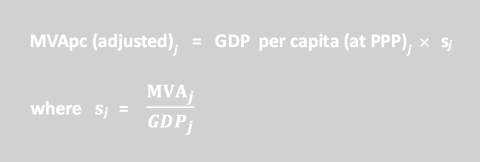How does UNIDO group countries by stage of development?
UNIDO’s statistical and research publications have used MVA per capita to differentiate between country groups, however, this approach was not strictly followed due to the problem of a comparable valuation of output in different countries. At the level of an economy as a whole, countries’ socio-economic performance can be compared based on GDP at purchasing power parity (PPP), which eliminates the difference between the nominal currency exchange rates and the actual prices of goods and services in different countries. PPP is based on the price of a basket of consumer goods derived from different types of economic activities, and serves as a composite factor of adjustment for exchange rates. There is, however, no similar price comparator at the level of the manufacturing sector. Therefore, for the purpose of country classification, UNIDO uses an adjusted value of MVA per capita (at PPP), which is obtained as a product of two ratio variables:

MVApc (adjusted) is an implicit estimate of MVA per capita at PPP. This is the basic measure underlying the country groups in UNIDO statistics. It corresponds with the results of a UNIDO study which concludes that the share of MVA in GDP does not increase beyond a certain point once the country has reached its highest level of industrialization. GDP per capita at this point is estimated to be 13,000 international dollars (PPP) (see [1]). The share of MVA in GDP at this particular level of economic development is around 20 percent. Based on these figures, UNIDO concludes that an economy is considered ‘industrialized’ if its adjusted MVA per capita exceeds 2,500 international dollars (PPP).
Country group categories
UNIDO’s country groups comprise two main categories: i) industrialized economies and ii) developing and emerging industrial economies. The basic criterion of this classification is MVA per capita. Additional measures were used to include very high-income economies— predominantly offshore economies—in the group of industrialized economies. The group of developing and emerging industrial economies replaces the former group of developing countries. It consists of four sub-groups: i) emerging industrial economies, ii) China, iii) other developing economies, and iv) least developed countries (LDCs). Details on the country groups used in UNIDO statistics are provided in a separate UNIDO publication as well as in the International Yearbook of Industrial Statistics (see [2]).
Country groups meet the following requirements of UNIDO's research and statistics activities:
- Setting up the modality of aggregation to monitor changes in the overall pattern of economic growth and structure;
- Enabling international comparisons to determine the leading regions and country groups and those lagging behind;
- Providing a basis for statistical analyses using basic and advanced methods, such as computation of mean value at the aggregated level, margin of variation, outlier detection and distribution pattern.
MVA per capita is a generalized measure. Provided that data is available, it would be more accurate to consider MVA in relation to the total number of employees or, better yet, to the total number of hours worked (UNIDO, 2010). Such a measure would allow us to identify possible inequalities with reference to industrial development on a global scale; possible centres of industrialization (or lack thereof) might be useful for decisions on international aid or other forms of economic cooperation. The production and technological capabilities of countries at different stages of economic development vary. The technologies countries employ in production differ as do their leading industries. This makes country comparability difficult and suggests the need to benchmark countries that are at the same stage of development, in other words, those countries that tend to have similar production/technological structures.
Grouping countries according to their MVA per capita is not the only way to analyse countries’ industrial development. Countries could also be grouped using cluster analysis techniques or simply selecting other development indicators. The number of comparators is actually of less importance than the selection criteria adopted. As highlighted in the IDR 2005: “There is no optimal number of comparators, and different countries may be used different purposes. A large number of comparators from across the world may be used (assuming that the data is readily available) to assess performance for broad issues like MVA or export performance, technology structures or inward FDI. A smaller set may be used to assess other variables like skill formation, R&D or risk ratings” (UNIDO, 2005: 9). A classification based on MVA per capita is not the only method applied in UNIDO statistics. UNIDO also groups countries by ‘income category’ like the World Bank as well as into ‘special groups’.
The country groups have a regional dimension as well. A regional distribution of MVA makes a focus on the industrial development of countries in a specific geographic area possible. This is of particular interest for countries seeking to benchmark their ‘local’ industrial development and, specifically, to identify comparable countries in their regional area or continent. Regional comparisons also provide information on inequalities within and across regions in the world. Thus, UNIDO Statistics’ new country groups reflect countries’ stage of industrialization, geographic region and income category. The country groups also include special groups of interest for data users. In this report, we use the first country group based on stage of industrialization, although disaggregated figures are presented so that ad hoc analyses based on geographical or income comparators can also be conducted.
Relevant reading
[1] In Search of General Patterns of Manufacturing Development; Working Paper by Haraguchi & Rezonja; UNIDO, 2010.
[2] UNIDO, International Yearbook of Industrial Statistics, 2013, Edward Elgar, UK.
[3] Antonio Andreoni and Shyam Upadhyaya (2014) Growth and distribution pattern of the world manufacturing output: A statistical profile, UNIDO working paper 2/2014, download pdf.
[4] Shyam Upadhyaya (2013) Country grouping in UNIDO statistics, UNIDO working paper 1/2013, download pdf.
